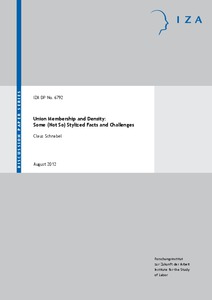Union membership and density: some (not so) stylized facts and challenges
"Surveying some recent data and the empirical literature from various disciplines, this paper attempts to shed some light on what we know and don't know about (trends in) unionization and its determinants in advanced countries. It shows that there are relatively few robust stylized facts,...
| Main Author: | |
|---|---|
| Institution: | ETUI-European Trade Union Institute |
| Format: | TEXT |
| Language: | English |
| Published: |
Bonn
2012
IZA |
| Subjects: | |
| Online Access: | https://www.labourline.org/KENTIKA-19132422124919506049-union-membership-and-density-s.htm |
| Summary: | "Surveying some recent data and the empirical literature from various disciplines, this paper attempts to shed some light on what we know and don't know about (trends in) unionization and its determinants in advanced countries. It shows that there are relatively few robust stylized facts, for instance that unionization is positively related to public sector employment, to establishment size and to the business cycle (with union growth being procyclical). The existence of a union-administered unemployment insurance and unions' presence at the workplace also play a positive role for (changes in) unionization. However, some seemingly obvious explanations for the decline in unionization over the last decades do not hold on closer scrutiny. Various trends like the ongoing economic globalization and changes in the sectoral structure of the economy and the composition of the workforce do not seem to have impeded union membership and density everywhere. Similarly, the trend towards decentralization of collective bargaining has not resulted in large-scale deunionization. It also remains an open question whether changes in social values, rising individualism, and changing attitudes of employees towards unions have affected or will affect unionization negatively." |
|---|---|
| Physical Description: | 1 v. Digital |

